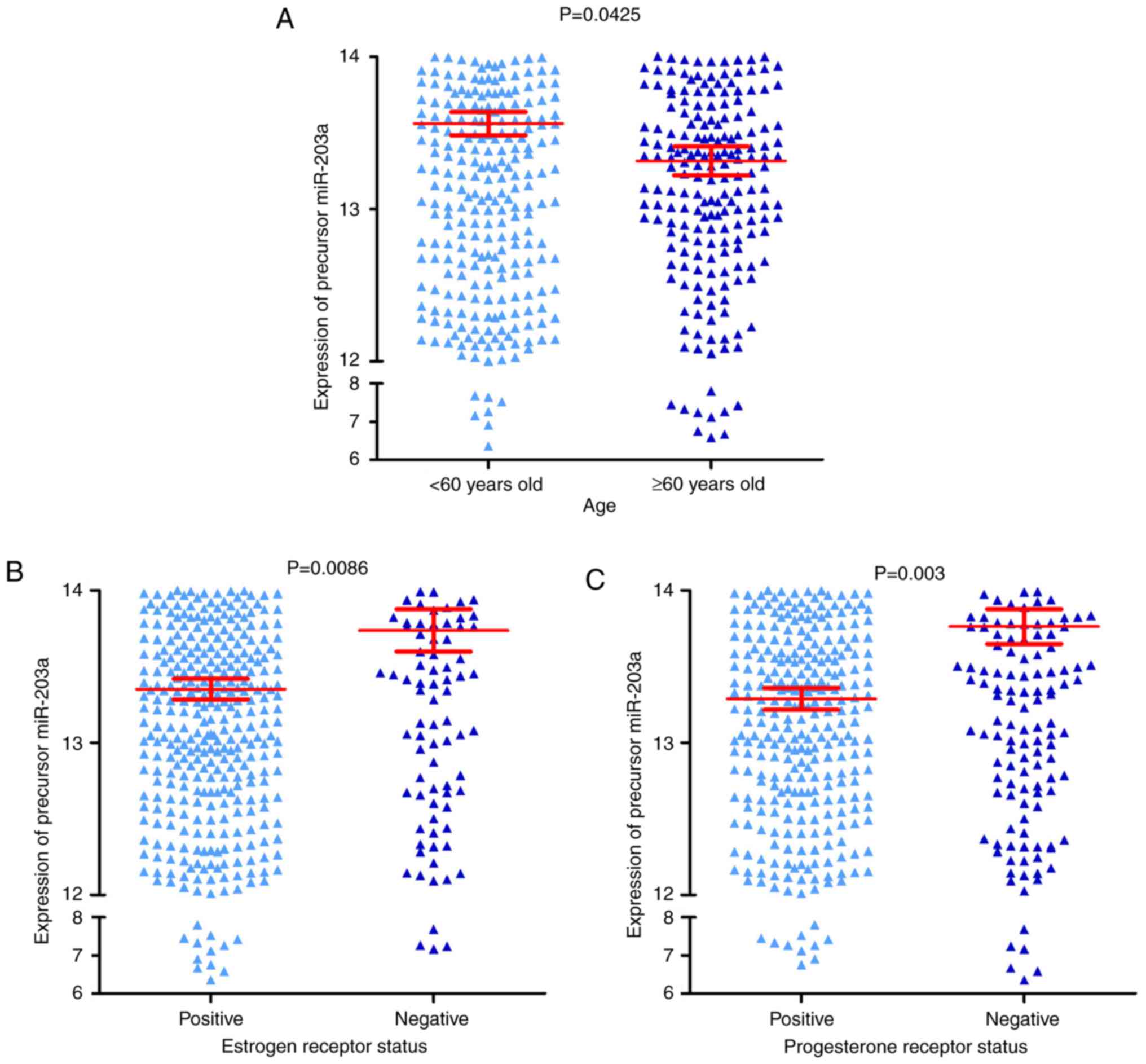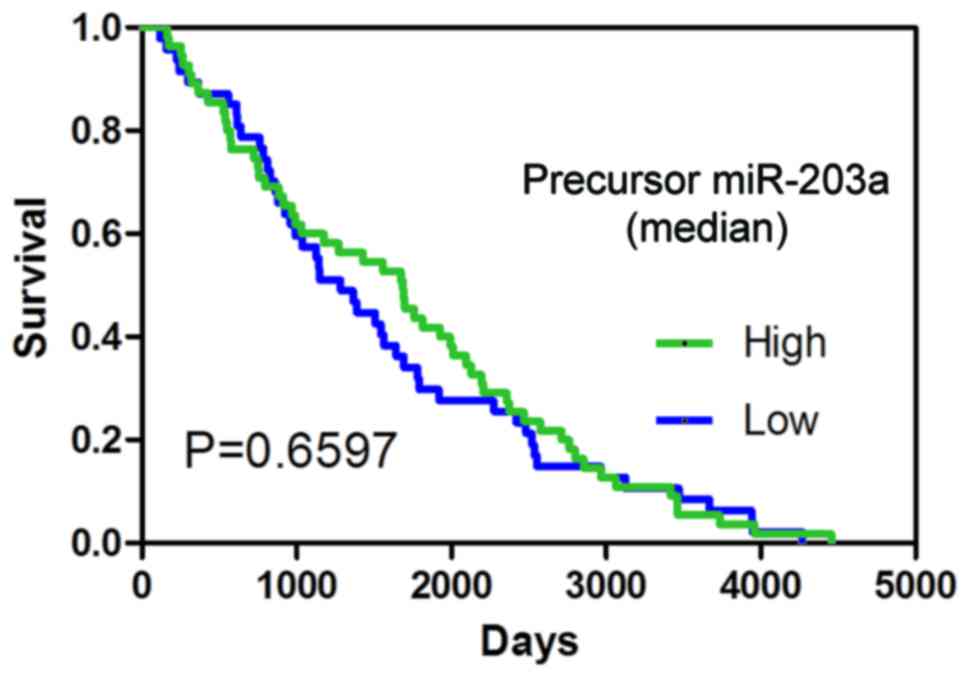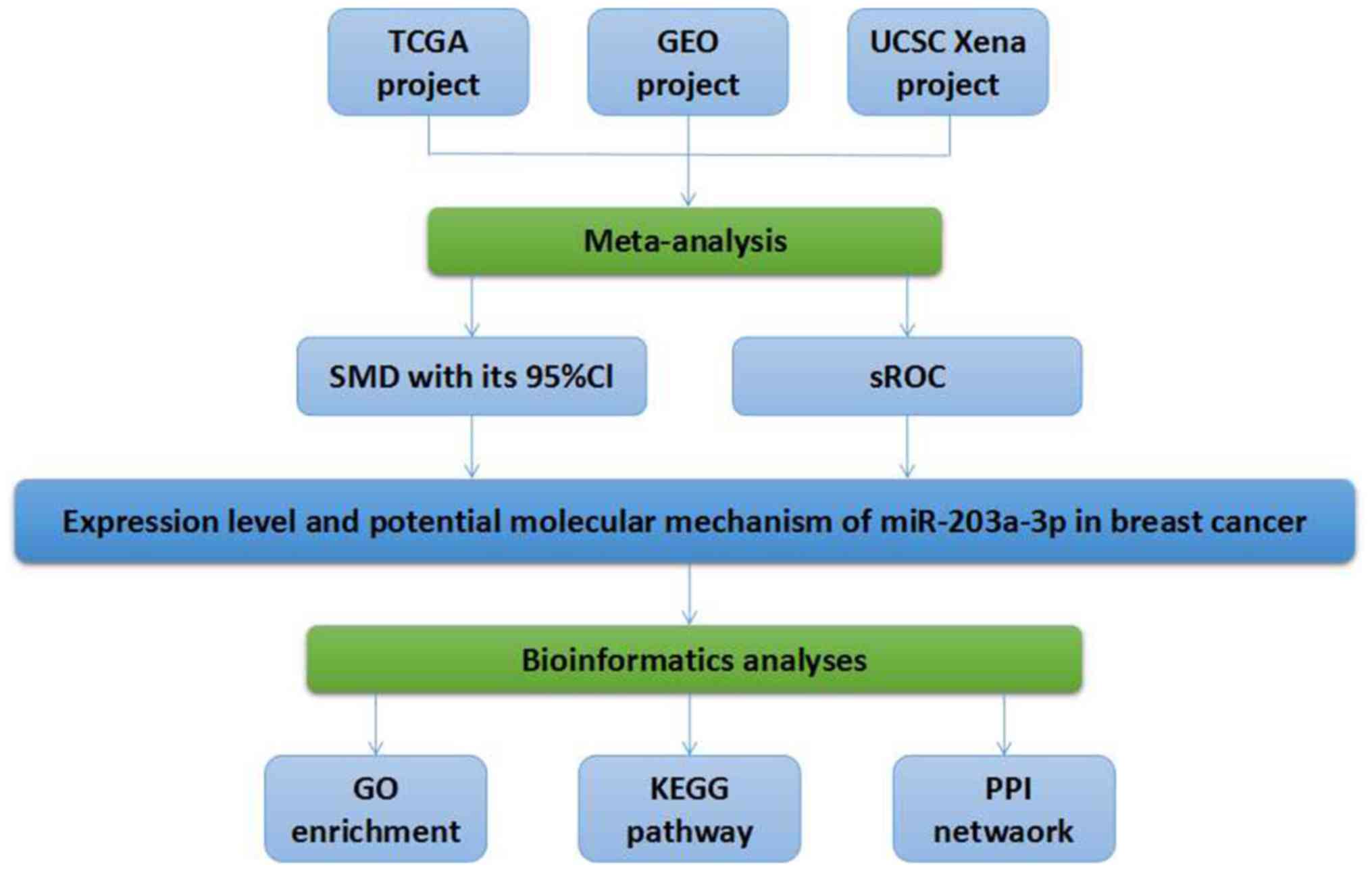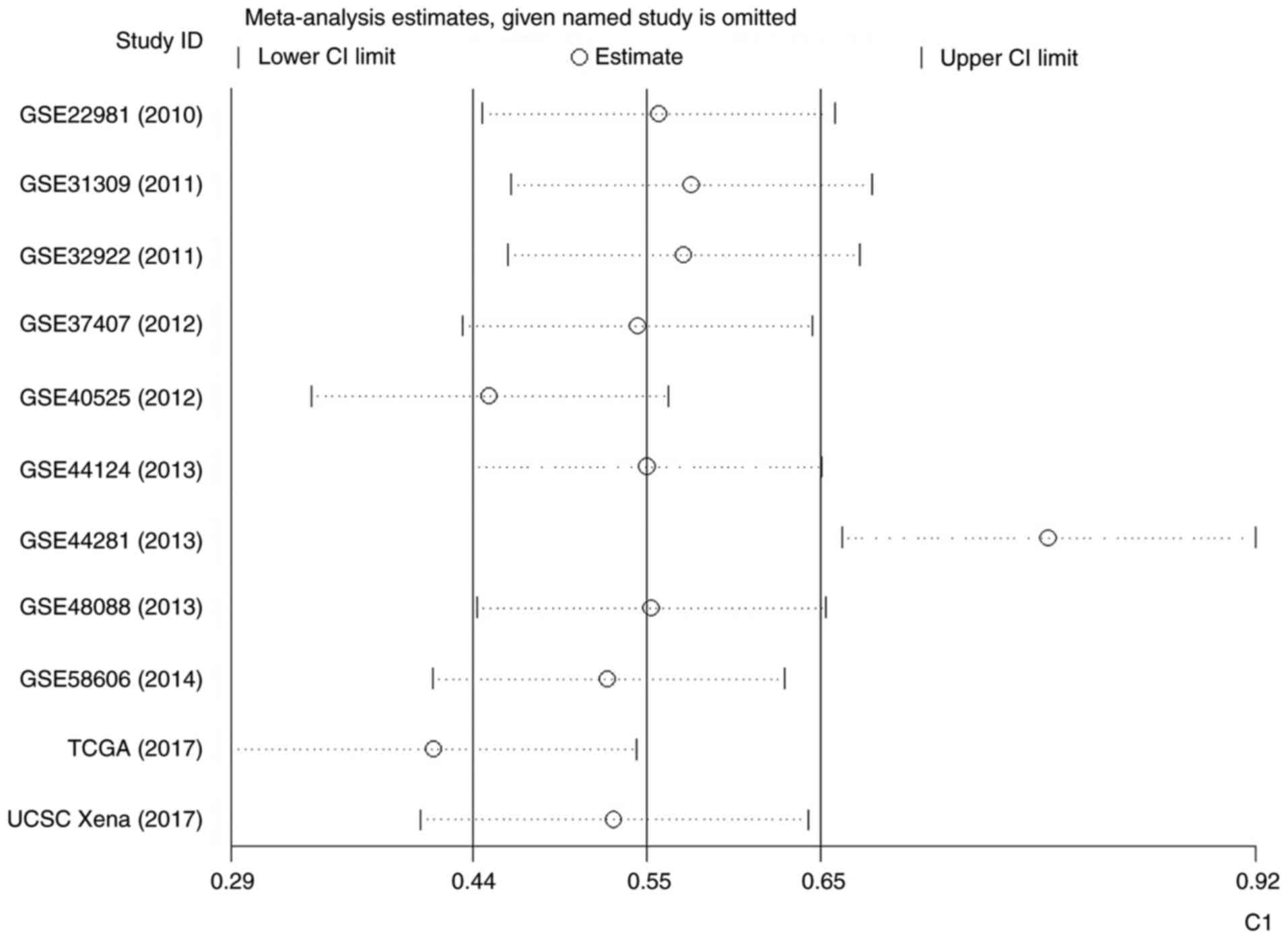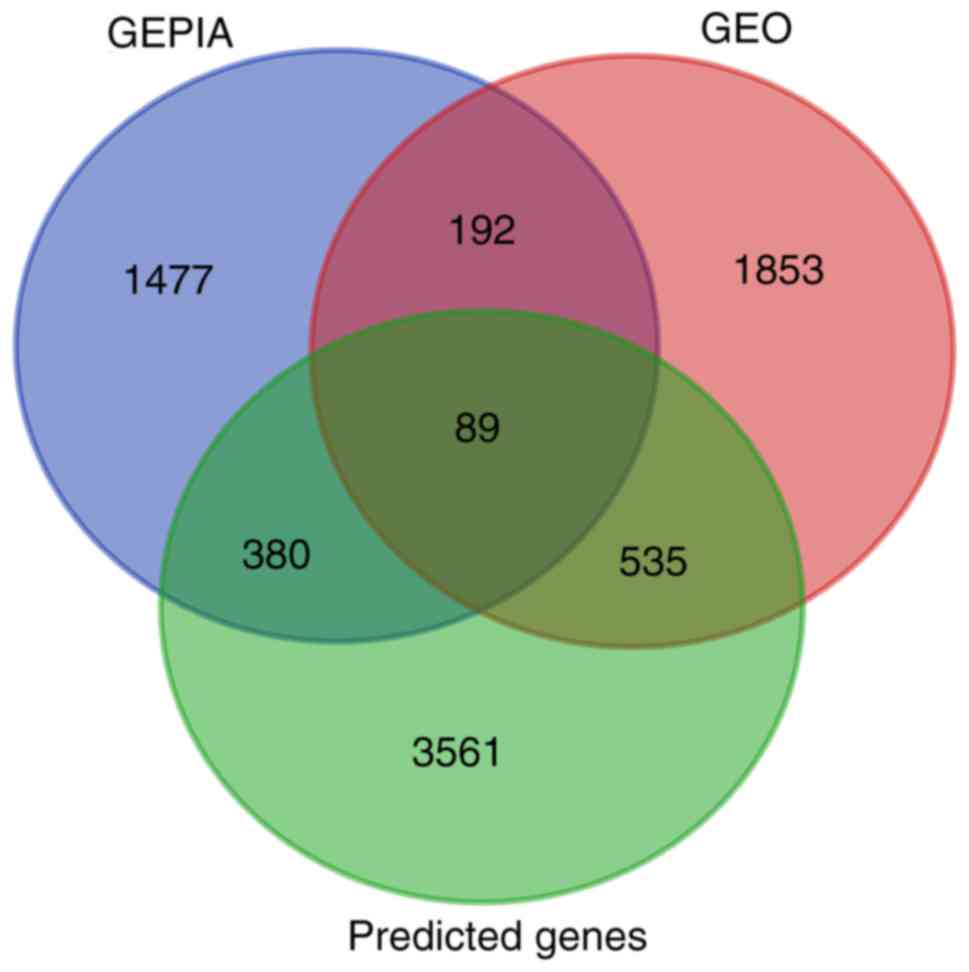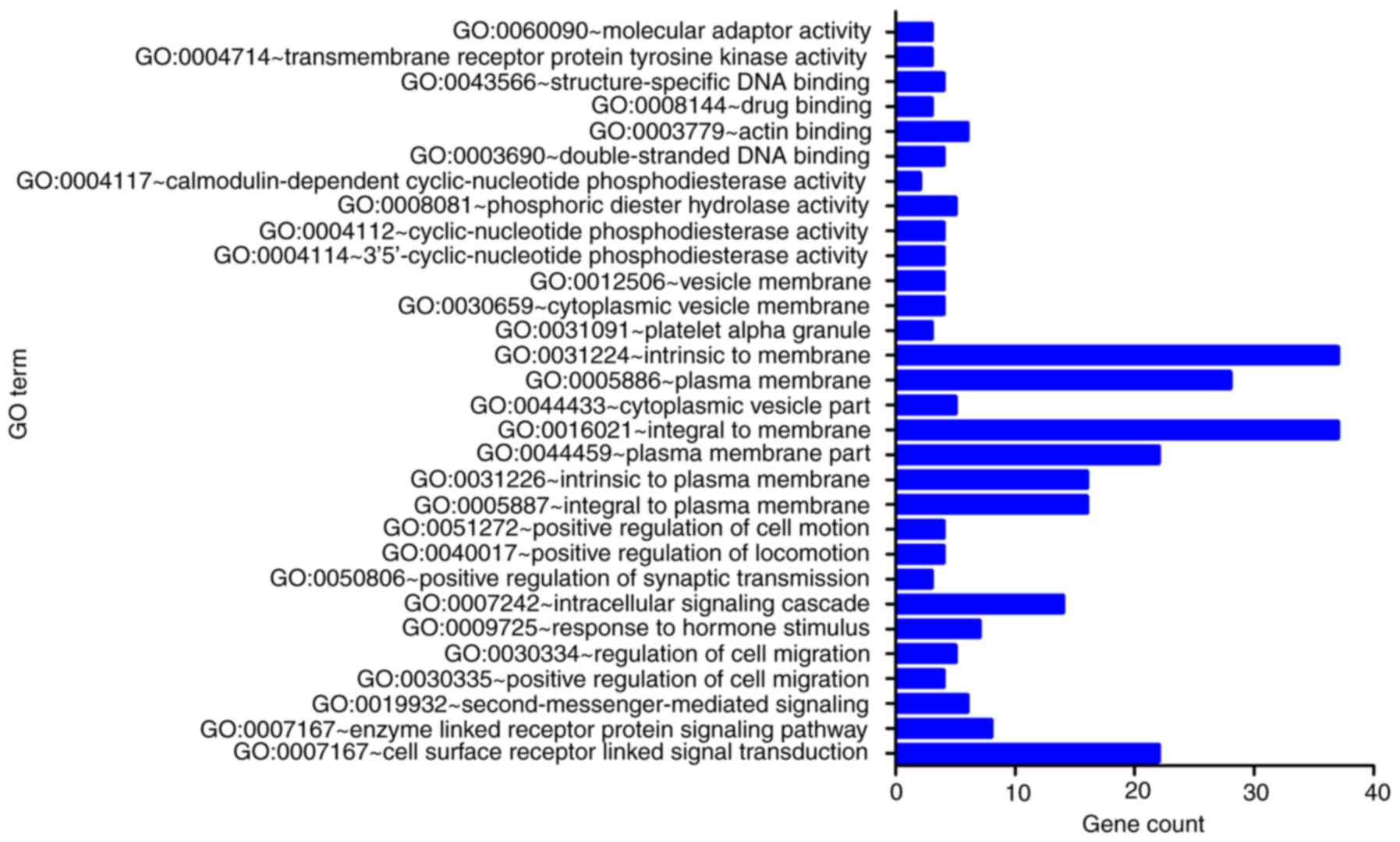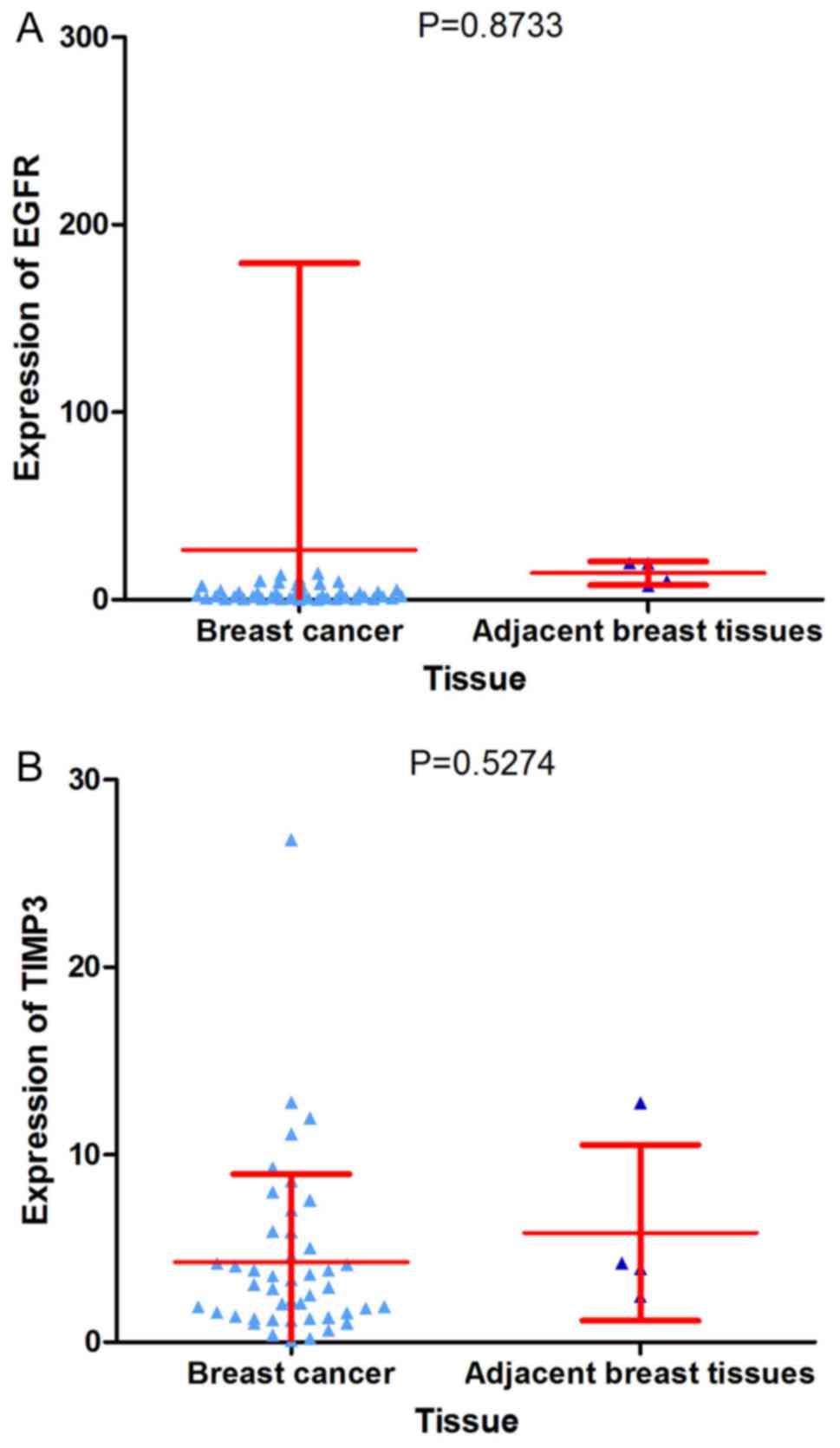Upregulated miR‑203a‑3p and its potential molecular mechanism in breast cancer: A study based on bioinformatics analyses and a comprehensive meta‑analysis
- Authors:
- Published online on: October 10, 2018 https://doi.org/10.3892/mmr.2018.9543
- Pages: 4994-5008
-
Copyright: © Cai et al. This is an open access article distributed under the terms of Creative Commons Attribution License.
Abstract
Introduction
Breast cancer (BC) ranks as the most common malignancy in women worldwide and ranks as the second most common cause of cancer-associated mortality (1,2). The incidence of BC is increasing; the latest cancer statistics from the USA estimated that the expected numbers of new cancer cases and mortalities could reach 66,120 and 40,920, respectively, in 2018 (3). The human epidermal growth factor receptor 2 (HER2), progesterone receptor (PR), and estrogen receptor (ER) were established as the biomarkers of BC, and BC can be classified into four molecular subtypes depending on the expression of HER2, PR and ER: HER2(+), triple negative breast cancer, Luminal A and Luminal B. Currently, advanced therapeutic approaches have been applied in BC cases to improve the 5-year survival rate based on the above classification, including chemotherapy, surgical techniques and adjuvant radiotherapy (4–8). Nevertheless, the 5-year survival rate of BC patients with distant metastasis and tumor progression is only 26%. Additionally, only 1.9% of patients under 50 with BC received a BC diagnosis, but ~80% of BC patients over 50 received a BC diagnosis. Therefore, an improved understanding of potential treatment targets is imperative to improve the 5-year survival rate and diagnosis of patients with BC (9,10).
MicroRNAs (miRNAs/miRs) are small, non-coding RNAs of ~22 nucleotides. They regulate the expression of proteins by silencing the transcripts of target genes or inhibiting the translation of mRNA (11,12). Extensive studies have established that miRNAs are crucial in the diagnosis, proliferation, prognosis, invasion, apoptosis, migration and metastasis of cancer (13–17). For example, Liang et al suggested that miRNA-10b was a suppressor in BC growth, migration, proliferation and invasion (18). Du et al reported that miR-124 inhibited the proliferation and migration of BC by targeting snail family transcriptional repressor 2 (19).
Located at 14q32.33 chromosome, miR-203a-3p may possess a vital role in cancer. It has been reported that miR-203a-3p can suppress hepatocellular carcinoma progression by targeting homeobox D3 through the EGFR signaling pathway (20). However, only one study has examined the role of miR-203a-3p in BC based on 109 BC cases and matched normal breast (21). Therefore, it is critical to establish the molecular mechanism of miR-203a-3p in BC with a large number of samples. The present study estimated the expression of precursor miR-203a and miR-203a-3p in BC tissue and adjacent breast tissue by combing data from The Cancer Genome Atlas (TCGA), Gene Expression Omnibus (GEO) and University of California Santa Cruz (UCSC) Xena projects. In addition, the potential molecular mechanisms of miR-203a-3p in BC were investigated through gene ontology (GO) enrichment, Kyoto Encyclopedia of Genes and Genomes (KEGG) pathways analysis and protein-protein interaction (PPI).
Materials and methods
Expression of miRNA in TCGA and UCSC Xena projects
The TCGA data with level 3 miRNA-Seq profiles and full annotation of clinical parameters were acquired from TCGA (http://cancergenome.nih.gov/) (22). Additionally, the expression of miR-203a-3p was downloaded from the UCSC Xena project (http://xena.ucsc.edu/) (23).
Selection of BC microarrays from GEO data
The GEO (https://www.ncbi.nlm.nih.gov/geo/) (24) was used to download BC-associated microarrays with the following prerequisites: (Breast OR mammary) AND (carcinoma OR tumor OR tumor OR neoplas* OR adenocarcinoma OR malignan* OR cancer). Microarrays were selected using the following criteria: The microarrays should include BC tissue and adjacent breast tissue, and the expression of miR-203a-3p in the two types of tissue should be provided. A gene expression profile named GSE50697 was screened to identify the differentially expressed genes (DEGs).
Selection of prospective DEGs and target genes of miR-203a-3p in BC
The prospective target genes of miR-203a-3p were obtained from miRWalk2.0 databases (http://zmf.umm.uni-heidelberg.de/apps/zmf/mirwalk2/) (25), which included 12 online prediction tools: miRDB, miRNAMap, RNAhybrid, miRBridge, miRMap, PICTAR2, PITA, MicroT4, TargetScan, miRWalk2.0, miRanda and RNA22. Prospective target genes were selected if they appeared at least four times in the above 12 online prediction tools to augment the accuracy of the prediction. Gene Expression Profiling Interactive Analysis (http://gepia.cancer-pku.cn/index.html) (26) was performed to acquire the DEGs from TCGA with P<0.05 and log2 fold change >1. DEGs from GEO were achieved by using GEO2R (ncbi.nlm.nih.gov/geo/geo2r/) to analyze GSE50697 with P<0.05 and log2 fold change <-1.
Bioinformatics analyses
Venn diagrams were created to obtain the intersection of prospective target genes, such as DEGs from GEO and DEGs from TCGA, and to identify the potential target genes of miR-203a-3p in BC (27). Subsequently, GO and KEGG pathway analyses were used to confirm the potential mechanism of miR-203a-3p in BC (28,29). PPI analysis was also undertaken using the Search Tool for the Retrieval of Interacting Genes/Proteins (STRING) version 9.1 database (https://string-db.org/) (30–32) to generate an association between the possible target genes and hub genes were selected by counting the number of edges and nodes.
Statistical analyses
Student's t-test was used to evaluate statistically significant differences between two groups. Simultaneously, one way analysis variance and Dunnett's test were carried out to estimate statistically significant differences between multiple groups. The receiver operating characteristic (ROC) curve was adopted to assess the distinguishability of precursor miR-203a and miR-203a-3p between BC tissue and adjacent breast tissue. The Kaplan-Meier survival analysis was undertaken to evaluate the prognostic value of precursor miR-203a in BC. The log-rank test was used to compare high and low precursor miR-203a expression groups. STATA version 12.0 (StataCorp LP, College Station, TX, USA) was used to perform the statistical analyses of the meta-analysis in the present study. The standard mean difference (SMD) with a random effects model was used to measure the expression of miR-203a-3p in BC tissue and adjacent breast tissue. To identify the heterogeneity of the studies, a heterogeneity test was performed and the level of I2 calculated simultaneously. An influence analysis was also conducted to ensure the source of heterogeneity. Concurrently, a funnel plot asymmetry test was undertaken to assess the publication bias, with P<0.05 indicating significant publication bias. The distinguishability of miR-203a-3p in BC tissue and adjacent breast tissue was estimated using a summarized ROC (sROC) approach, with an area under the curve (AUC) >0.7 indicting an ability to distinguish miR-203a-3p in BC. Spearman's correlation analysis was used to verify the correlation between miR-203a-3p and target genes based on TCGA data. r>0 and r<0 indicated a positive and negative correlation, respectively,
Results
Clinical value of precursor miR-203a and miR-203a-3p in BC, using TCGA and UCSC Xena data
The expression of precursor miR-203a was markedly elevated in 1,077 BC tissue cases compared to 104 adjacent breast tissue cases according to TCGA project data (13.45±1.97 vs. 11.69±1.72, P<0.001; Fig. 1A). Subsequently, the expression of miR-203a-3p was substantially upregulated in 756 BC tissue cases compared to 76 adjacent breast tissue cases in UCSC Xena project data (11.68±1.97 vs. 10.49±1.05; P<0.001; Fig. 1B). Regarding the distinguishability of precursor miR-203a and miR-203a-3p, the AUC of ROC curve was 0.775 (P<0.0001; Fig. 1C) with a sensitivity of 59.24% and a specificity of 89.42%, which implied that precursor miR-203a could be used to distinguish between BC tissue and adjacent breast tissue. The AUC of ROC in the UCSC Xena project was 0.756 (P<0.0001; Fig. 1D) with a sensitivity of 61.51% and a specificity of 88.16 %, which indicated that miR-203a-3p could be used to distinguish between BC tissue and adjacent breast tissue. It was also identified that the expression of precursor miR-203a was increased in three groups, including the <60 years old group, the negative ER group and the negative PR group, compared with their corresponding groups, the ≥60 years old group, the positive ER group and the positive PR group (all P<0.05; Fig. 2A-C, and Table I). The result of the survival analysis indicated that precursor miR-203a possessed no prognostic value in BC (Fig. 3).
Clinical value of miR-203a-3p in BC, using GEO data
Finally, nine GEO microarrays with 611 BC tissue samples and 379 adjacent breast tissue samples were selected for further analysis (Fig. 4). It was identified that the expression of miR-203a-3p was significantly upregulated in BC tissue compared with adjacent breast tissue in 3 GEO microarrays (GSE37407, GSE40525 and GSE58606, all P<0.05; Fig. 5). The ROC curve of these three microarrays also implied that miR-203a-3p could be used to distinguish between BC tissue and adjacent breast tissue (Fig. 6).
Meta-analysis
The result of SMD revealed that the expression of miR-203a-3p was markedly increased in 2,444 BC tissue cases compared with 559 adjacent breast tissue cases. The heterogeneity test indicated that there was significant heterogeneity in the included studies (I2=91.5%; P=0.000; 95% CI, 0.44–0.65; Fig. 7). Therefore, an influence analysis was conducted to seek the source of heterogeneity and it was identified that GSE44281 was significantly different from the other 10 studies (Fig. 8). Following the omission of GSE44281, the level of I2 was decreased, but still reached 86.9% (Fig. 9). The outcome of a funnel plot asymmetry test indicated that no publication bias was identified in the included studies (Fig. 10). The AUC of sROC reached 0.82 with a sensitivity of 0.70 (0.54–0.82) and a specificity of 0.81 (0.63–0.91), which implied that miR-203a-3p could be used to distinguish between BC tissue and adjacent breast tissue (Figs. 11 and 12).
GO enrichment, KEGG pathway analyses and PPI network
Online prediction tools were used to acquire a total of 4,565 predicted target genes, which had to appear at least four times in searches to qualify. Meanwhile, 2,669 DEGs from GEO and 2,138 DEGs from TCGA were acquired. Of these DEGs, 89 genes intersected with the predicted target genes (Fig. 13). The result of GO enrichment analysis indicated that the overlapped genes were associated with ‘plasma membrane integrity’, ‘cell surface receptor linked signal transduction’ and ‘3′,5′-cyclic nucleotide phosphodiesterase activity’ (Fig. 14; Table II). In addition, a pathway termed ‘purine metabolism’ was identified to be closely associated with miR-203a-3p expression in BC via its target genes, including phosphodiesterase 1C (PDE1C), adenylate cyclase 5 (ADCY5), phosphodiesterase 1A (PDE1A), phosphodiesterase 5A (PDE5A) and phosphodiesterase 8B (PDE8B; Table III). Notably, the expression of three genes (PDE1A, PDE1C and PDE8B) was significantly reduced in BC tissue compared with adjacent breast tissue. The other genes demonstrated a reduced trend in BC tissue compared to adjacent breast tissue, but no statistical significance was observed (Fig. 15). Spearman's correlation analysis identified that ADCY5 was negatively correlated with miR-203a-3p. A minor negative correlation was identified between the other four genes and miR-203a-3p, but no statistical significance was observed (Fig. 16). The ROC demonstrated that all these genes could be used to distinguish between BC tissue and adjacent breast tissue (Fig. 17). Through the PPI network, four hub genes were identified: Epidermal growth factor receptor, ADCY5, metalloproteinase inhibitor 3 and insulin-like growth factor 1 (IGF1; Fig. 18). Depending on data from TCGA, it was identified that only IGF1 was predominantly decreased in BC tissue compared with adjacent breast tissue (Figs. 15A, 19 and 20A). As the expression of the hub genes should be decreased in BC tissue compared with adjacent breast tissue, IGF1 was identified as the hub gene of miR-203a-3p in BC. Furthermore, IGF1 exhibited a distinction between BC tissue and adjacent breast tissue with an AUC of ROC that reached 0.9348 (Fig. 20B). Additionally, a slight negative correlation was identified between IGF1 and miR-203a-3p according to the Spearman's correlation analysis; however, the correlation was not statistically significant (r=−0.1611; P=0.4038; Fig. 20C).
Discussion
Previous studies have identified that miR-203a-3p is significantly associated with various cancers; a trend of miR-203a-3p elevation has been detected in hepatocellular (33) and colorectal (34) carcinoma. By contrast, downregulated miR-203a-3p expression was detected in gastric cancer (35), prostate cancer (36), non-small-cell lung carcinoma (37) and esophageal cancer (38). However, only one study has identified the expression and potential functions of miR-203a-3p in BC; Gomes et al (21) reported that the expression of miR-203a-3p was markedly upregulated in 109 BC samples compared with matched normal breast samples and also identified that upregulated expression of miR-203a-3p was established in five clinic pathological characteristics groups: Tumor size ≤18.5 mm, HER2-negative, PR-positive, ER-positive and high Ki-67 index groups.
Since the sample size of the study by Gomes et al (21) was not large or varied enough, the current study combined data from three projects with a larger sample size to ensure the accuracy of the results. It was identified that the expression of precursor miR-203a was significantly elevated in 1,077 BC tissue samples compared with 104 adjacent breast tissue samples in TCGA project data. In the UCSC Xena project, the expression of miR-203a-3p was significantly increased in 756 BC tissue cases compared with 76 adjacent breast tissue cases. In addition, an elevated trend was detected in BC tissues compared with adjacent breast tissue in three GEO microarrays. The outcome of the comprehensive meta-analysis indicated that the expression of miR-203a-3p trended toward overexpression in 2,444 BC tissue cases compared with 559 adjacent breast tissue cases. Additionally, ROC and sROC suggested that miR-203a-3p could be used to distinguish between BC tissue and adjacent breast tissue. It was detected that upregulated miR-203a-3p was associated with age (<60-year-old patients), PR-negative BC tissue and ER-negative BC tissue. Regarding the prognosis value of miR-203a-3p in BC, no prognostic value was observed. Taken together, it was hypothesized that miR-203a-3p may enhance the development and oncogenesis of BC.
GO enrichment and KEGG pathway analyses were conducted to identify the potential molecular mechanism of the role of miR-203a-3p in BC. The predicted miR-203a-3p target genes were significantly enriched in three biological processes: ‘Plasma membrane’, ‘cell surface receptor linked signal transduction’ and ‘3′,5′-cyclic nucleotide phosphodiesterase activity’. Therefore, it was hypothesized that miR-203a-3p may influence BC via the above processes. In addition, a pathway termed ‘purine metabolism’ was closely associated with miR-203a-3p target genes. The expression and ROCs of the pathway-related genes were assessed; the expression of three genes (PDE1C, PDE1A and PDE8B) was significantly decreased in BC tissue compared with adjacent breast tissue and the expression of other genes (PDE5A and ADCY5) was marginally reduced in BC tissue compared with adjacent breast tissue, but the change was not statistically significant. ROCs from these five genes indicated that each was able to distinguish BC from adjacent normal tissue. In addition, it was detected that ADCY5 expression was negatively correlated with miR-203a-3p expression. Taken together, the findings indicate that miR-203a-3p may be involved in purine metabolism in BC by targeting ADCY5, PDE1C, PDE1A, PDE5A and PDE8B.
Finally, the hub gene IGF1 was selected for further investigation. IGF1 is regarded as a vital gene in regulating cell differentiation, apoptosis and proliferation in BC. IGF1 polymorphisms may enhance the risk for BC (39). De Santi et al (40) demonstrated that IGF1 is comprised a pro-form and mature form. The IGF1 pro-form enhances cell proliferation in BC via IGF1 receptor. The current study evaluated the expression and diagnostic ability of IGF1 in BC tissue and adjacent breast tissue. It was identified that the expression of IGF1 was reduced in BC tissue compared with adjacent breast tissue and IGF1 could be used to distinguish BC tissue; however, the negative correlation between IGF1 and miR-203a-3p expression was not statistically significant. The findings of the present study suggested that miR-203a-3p may be involved in certain pivotal processes in BC by targeting IGF1.
Although certain findings were acquired from the comprehensive meta-analysis and bioinformatics analyses, there are limitations of the current study. The heterogeneity test indicated that there was significant heterogeneity in the included studies; although an attempt was made to solve this. Unfortunately, the level of I2 was still >50% following the omission of the source of heterogeneity. It was hypothesized that the following factors may have resulted in the significant heterogeneity: i) The GEO microarrays were acquired from different countries with four microarrays obtained from Spain (GSE32922, GSE44124, GSE48088 and GSE58606), two microarrays obtained from USA (GSE22981, GSE44281) and GSE31309, GSE37407 and GSE40525 were acquired from Germany, Sweden and Israel, respectively; ii) the approaches for determining the expression of miR-203a-3p were different across the different studies. Various platforms were conducted to analyze GEO microarrays. Furthermore, in vitro or in vivo experiments to support the hypothesis of the present study were not performed, which is a major limitation. Thus, in vitro and in vivo studies should be performed in the near future.
In general, the present study established that the expression of miR-203a-3p was markedly elevated in BC tissue compared with adjacent breast tissue. Thus, it is hypothesized that miR-203a-3p may enhance the development and oncogenesis of BC. In addition, the target gene IGF1 was identified as a hub gene of miR-203a-3p in BC while the expression of IGF1 was significantly reduced in BC tissue compared with adjacent breast tissue.
Acknowledgements
Not applicable.
Funding
The present study was funded by Guangxi Zhuang Autonomous Region University Student Innovative Plan (grant no. 201710598065).
Availability of data and materials
The data and materials of the present study are available from the corresponding authors on reasonable request.
Authors' contributions
CF, JZha, RH and JM collected and analyzed the data. KC and JZho conceived the study and wrote the manuscript. All authors read the final version of the manuscript.
Ethics approval and consent to participate
Not applicable.
Patient consent for publication
Not applicable.
Competing interests
The authors declare that they have no competing interests.
References
|
Jalali C, Ghaderi B, Amini S, Abdi M and Roshani D: Association of XRCC1 Trp194 allele with risk of breast cancer, and Ki67 protein status in breast tumor tissues. Saudi Med J. 37:624–630. 2016. View Article : Google Scholar : PubMed/NCBI | |
|
Liang Z and Xi Y: MicroRNAs mediate therapeutic and preventive effects of natural agents in breast cancer. Chin J Nat Med. 14:881–887. 2016.PubMed/NCBI | |
|
Siegel RL, Miller KD and Jemal A: Cancer statistics, 2018. CA Cancer J Clin. 68:7–30. 2018. View Article : Google Scholar : PubMed/NCBI | |
|
Shou D, Wen L, Song Z, Yin J, Sun Q and Gong W: Suppressive role of myeloid-derived suppressor cells (MDSCs) in the microenvironment of breast cancer and targeted immunotherapies. Oncotarget. 7:64505–64511. 2016. View Article : Google Scholar : PubMed/NCBI | |
|
Xing L, He Q, Wang YY, Li HY and Ren GS: Advances in the surgical treatment of breast cancer. Chin Clin Oncol. 5:342016. View Article : Google Scholar : PubMed/NCBI | |
|
Hennequin C, Barillot I, Azria D, Belkacémi Y, Bollet M, Chauvet B, Cowen D, Cutuli B, Fourquet A, Hannoun-Lévi JM, et al: Radiotherapy of breast cancer. Cancer Radiother. 20 Suppl:S139–S146. 2016.(In French). View Article : Google Scholar : PubMed/NCBI | |
|
Ejlertsen B: Adjuvant chemotherapy in early breast cancer. Dan Med J. 63:B52222016.PubMed/NCBI | |
|
Zhang X, Ren D, Guo L, Wang L, Wu S, Lin C, Ye L, Zhu J, Li J, Song L, et al: Thymosin beta 10 is a key regulator of tumorigenesis and metastasis and a novel serum marker in breast cancer. Breast Cancer Res. 19:152017. View Article : Google Scholar : PubMed/NCBI | |
|
Li Z and Kang Y: Emerging therapeutic targets in metastatic progression: A focus on breast cancer. Pharmacol Ther. 161:79–96. 2016. View Article : Google Scholar : PubMed/NCBI | |
|
Song JL, Chen C, Yuan JP and Sun SR: Progress in the clinical detection of heterogeneity in breast cancer. Cancer Med. 5:3475–3488. 2016. View Article : Google Scholar : PubMed/NCBI | |
|
Shen H and Li Z: miRNAs in NMDA receptor-dependent synaptic plasticity and psychiatric disorders. Clin Sci (Lond). 130:1137–1146. 2016. View Article : Google Scholar : PubMed/NCBI | |
|
Su W, Aloi MS and Garden GA: MicroRNAs mediating CNS inflammation: Small regulators with powerful potential. Brain Behav Immun. 52:1–8. 2016. View Article : Google Scholar : PubMed/NCBI | |
|
Zhou W, Zou B, Liu L, Cui K, Gao J, Yuan S and Cong N: MicroRNA-98 acts as a tumor suppressor in hepatocellular carcinoma via targeting SALL4. Oncotarget. 7:74059–74073. 2016. View Article : Google Scholar : PubMed/NCBI | |
|
Yang L, Liang H, Wang Y, Gao S, Yin K, Liu Z, Zheng X, Lv Y, Wang L, Zhang CY, et al: MiRNA-203 suppresses tumor cell proliferation, migration and invasion by targeting Slug in gastric cancer. Protein Cell. 7:383–387. 2016. View Article : Google Scholar : PubMed/NCBI | |
|
Gao Y, Feng B, Han S, Lu L, Chen Y, Chu X, Wang R and Chen L: MicroRNA-129 in human cancers: From tumorigenesis to clinical treatment. Cell Physiol Biochem. 39:2186–2202. 2016. View Article : Google Scholar : PubMed/NCBI | |
|
Ren W, Li C, Duan W, Du S, Yang F, Zhou J and Xing J: MicroRNA-613 represses prostate cancer cell proliferation and invasion through targeting Frizzled7. Biochem Biophys Res Commun. 469:633–638. 2016. View Article : Google Scholar : PubMed/NCBI | |
|
Hao W, Luo W, Bai M, Li J, Bai X, Guo J, Wu J and Wang M: MicroRNA-206 inhibited the progression of glioblastoma through BCL-2. J Mol Neurosci. 60:531–538. 2016. View Article : Google Scholar : PubMed/NCBI | |
|
Liang AL, Zhang TT, Zhou N, Wu CY, Lin MH and Liu YJ: MiRNA-10b sponge: An anti-breast cancer study in vitro. Oncol Rep. 35:1950–1958. 2016. View Article : Google Scholar : PubMed/NCBI | |
|
Du S, Li H, Sun X, Li D, Yang Y, Tao Z, Li Q and Liu K: MicroRNA-124 inhibits cell proliferation and migration by regulating SNAI2 in breast cancer. Oncol Rep. 36:3259–3266. 2016. View Article : Google Scholar : PubMed/NCBI | |
|
Wang L, Sun H, Wang X, Hou N, Zhao L, Tong D, He K, Yang Y, Song T, Yang J and Huang C: EGR1 mediates miR-203a suppress the hepatocellular carcinoma cells progression by targeting HOXD3 through EGFR signaling pathway. Oncotarget. 7:45302–45316. 2016.PubMed/NCBI | |
|
Gomes BC, Martins M, Lopes P, Morujão I, Oliveira M, Araújo A, Rueff J and Rodrigues AS: Prognostic value of microRNA-203a expression in breast cancer. Oncol Rep. 36:1748–1756. 2016. View Article : Google Scholar : PubMed/NCBI | |
|
Wu H and Zhang J: Decreased expression of TFAP2B in endometrial cancer predicts poor prognosis: A study based on TCGA data. Gynecol Oncol. 149:592–597. 2018. View Article : Google Scholar : PubMed/NCBI | |
|
Nasif D, Campoy E, Laurito S, Branham R, Urrutia G, Roqué M and Branham MT: Epigenetic regulation of ID4 in breast cancer: Tumor suppressor or oncogene? Clin Epigenetics. 10:1112018. View Article : Google Scholar : PubMed/NCBI | |
|
Zhang J, Lan Q and Lin J: Identification of key gene modules for human osteosarcoma by co-expression analysis. World J Surg Oncol. 16:892018. View Article : Google Scholar : PubMed/NCBI | |
|
Wang YW, Zhang W and Ma R: Bioinformatic identification of chemoresistance-associated microRNAs in breast cancer based on microarray data. Oncol Rep. 39:1003–1010. 2018.PubMed/NCBI | |
|
Hui HX, Hu ZW, Jiang C, Wu J, Gao Y and Wang XW: ZNF418 overexpression protects against gastric carcinoma and prompts a good prognosis. Onco Targets Ther. 11:2763–2770. 2018. View Article : Google Scholar : PubMed/NCBI | |
|
Wu N, Yan J, Han T, Zou J and Shen W: Integrated assessment of differentially expressed plasma microRNAs in subtypes of nonsyndromic orofacial clefts. Medicine (Baltimore). 97:e112242018. View Article : Google Scholar : PubMed/NCBI | |
|
Yan L, Zhan C, Wu J and Wang S: Expression profile analysis of head and neck squamous cell carcinomas using data from the cancer genome atlas. Mol Med Rep. 13:4259–4265. 2016. View Article : Google Scholar : PubMed/NCBI | |
|
Hou L, Lin Z, Ni Y, Wu Y, Chen D, Song L, Huang X, Hu H and Yang D: Microarray expression profiling and gene ontology analysis of long non-coding RNAs in spontaneously hypertensive rats and their potential roles in the pathogenesis of hypertension. Mol Med Rep. 13:295–300. 2016. View Article : Google Scholar : PubMed/NCBI | |
|
Li GM, Zhang CL, Rui RP, Sun B and Guo W: Bioinformatics analysis of common differential genes of coronary artery disease and ischemic cardiomyopathy. Eur Rev Med Pharmacol Sci. 22:3553–3569. 2018.PubMed/NCBI | |
|
Zhou W, Ma CX, Xing YZ and Yan ZY: Identification of candidate target genes of pituitary adenomas based on the DNA microarray. Mol Med Rep. 13:2182–2186. 2016. View Article : Google Scholar : PubMed/NCBI | |
|
Xu F, Gao F, Liu Y, Wang Z, Zhuang X, Qu Z, Ma H, Liu Y, Fu C, Zhang Q and Duan X: Bioinformatics analysis of molecular mechanisms involved in intervertebral disc degeneration induced by TNF-α and IL-1β. Mol Med Rep. 13:2925–2931. 2016. View Article : Google Scholar : PubMed/NCBI | |
|
Huo W, Du M, Pan X, Zhu X, Gao Y and Li Z: miR-203a-3p.1 targets IL-24 to modulate hepatocellular carcinoma cell growth and metastasis. FEBS Open Bio. 7:1085–1091. 2017. View Article : Google Scholar : PubMed/NCBI | |
|
Kara M, Yumrutas O, Ozcan O, Celik OI, Bozgeyik E, Bozgeyik I and Tasdemir S: Differential expressions of cancer-associated genes and their regulatory miRNAs in colorectal carcinoma. Gene. 567:81–86. 2015. View Article : Google Scholar : PubMed/NCBI | |
|
Liu W, Dong Z, Liang J, Guo X, Guo Y, Shen S, Kuang G and Guo W: Downregulation of potential tumor suppressor mir-203a by promoter methylation contributes to the invasiveness of gastric cardia adenocarcinoma. Cancer Invest. 34:506–516. 2016. View Article : Google Scholar : PubMed/NCBI | |
|
Riemann A, Reime S and Thews O: Hypoxia-related tumor acidosis affects MicroRNA expression pattern in prostate and breast tumor cells. Adv Exp Med Biol. 977:119–124. 2017. View Article : Google Scholar : PubMed/NCBI | |
|
Lin QH, Zhang KD, Duan HX, Liu MX, Wei WL and Cao Y: ERGIC3, which is regulated by miR-203a, is a potential biomarker for non-small cell lung cancer. Cancer Sci. 106:1463–1473. 2015. View Article : Google Scholar : PubMed/NCBI | |
|
Liu Y, Dong Z, Liang J, Guo Y, Guo X, Shen S, Kuang G and Guo W: Methylation-mediated repression of potential tumor suppressor miR-203a and miR-203b contributes to esophageal squamous cell carcinoma development. Tumour Biol. 37:5621–5632. 2016. View Article : Google Scholar : PubMed/NCBI | |
|
Costa-Silva DR, Barros-Oliveira MD, Borges RS, Tavares CB, Borges US, Alves-Ribeiro FA, Silva VC and Silva BB: Insulin-like growth factor 1 gene polymorphism and breast cancer risk. An Acad Bras Cienc. 88:2349–2356. 2016. View Article : Google Scholar : PubMed/NCBI | |
|
De Santi M, Annibalini G, Barbieri E, Villarini A, Vallorani L, Contarelli S, Berrino F, Stocchi V and Brandi G: Human IGF1 pro-forms induce breast cancer cell proliferation via the IGF1 receptor. Cell Oncol (Dordr). 39:149–159. 2016. View Article : Google Scholar : PubMed/NCBI |




